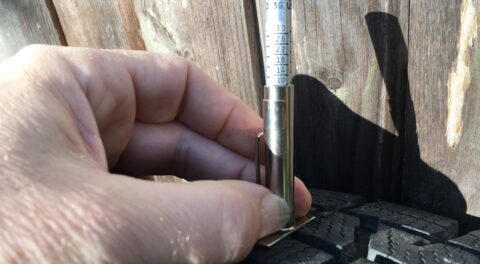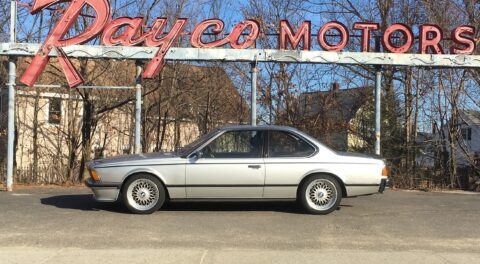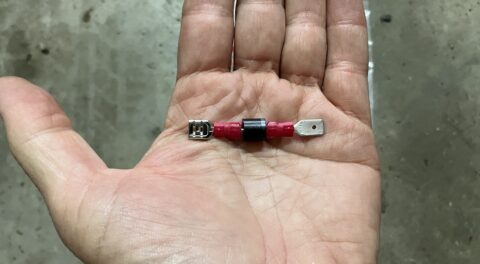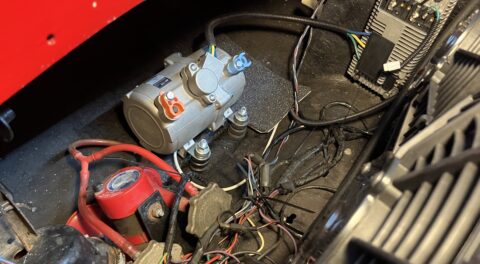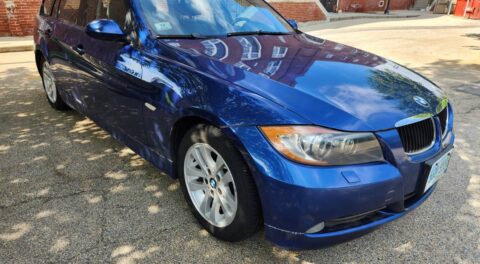Okaaaay, folks: After planning on putting Hampton, my 48,000-mile survivor ’73 2002, on the block last fall, pulling back, doing more work on it over the winter and spring that resulted in three BimmerLife piece about freaking hose clamps, the car is now—finally—on Bring a Trailer (BaT). The auction can be seen here, and ends Tuesday afternoon at 2:10 p.m. EST.
I’ve been tough on BaT, both in my January Roundel magazine piece and in a longer online piece I wrote for Hagerty, due to my experience listing my friend Mike’s ’73 2002tii with them last fall. I’ll recount some of that below, but let me say unequivocally that I’m grateful for the way BaT handled Hampton. Since the auction hasn’t closed yet, I don’t know the final price, but BaT allowed me some crucial and unexpected leeway, and I want to give them clear kudos for it.
But first let me lay into them one final time.
Folks joke about BaT’s formulaic listings that all start with “This [insert car year make and model here]” and include rubber-stamp phrases like “Power is routed to the wheels.” Their choice to have their listings all written in a dry house-voice doesn’t bother me at all; it’s part of BaT’s image that their listings are “curated,” and to the degree that you need to apply and have your car selected, they sort of are.
However, there are two things about BaT that really rub me the wrong way. The first is that their listing format seems engineered to insulate them from liability. They’re very hesitant to use terms like “original” in their descriptions, and anything with the slightest shred of doubt will be prefaced with “reportedly.” Many of us with vintage BMWs will send an email containing the VIN to BMW Archives to learn the car’s original color, but that may not be enough for BaT to state in the listing that the car is the original color. They encourage sellers to engage readers directly and tell their story in the comments, letting the peanut gallery of BaT readers chime in to crowd-source the truth, whatever the truth is—but you can’t tell me that the design of this model isn’t meant to shift liability away from BaT and to the seller.
From a business-model standpoint, I must admit that it’s really quite clever: They’ve designed an entertaining car-porn social-media platform where they crowd-source expertise without paying for it, present the cars as curated, and create click-and-bid confidence on expensive vehicles by strongly implying that the cars are somehow vetted when they’re really not—at least not in the sense of having a BaT-employed marque-specific expert physically examine the car, as a reputable auction house would. Moreover, the peanut-gallery comments are far from guaranteed to triangulate on the car-gods’ honest truth; the comments can be myopic or unfair, and people who are not bidding can pile on about trivial things.
The second thing that irks me is the description process itself. When I sell a car, I take a lot of pride in writing a lengthy, detailed description. This is far more than just my being a writer who can easily crank up the word count; it allows someone to have the kind of information they’d get if they saw the car in person. If a car is extremely rare or dead-mint, it may sell itself, but most cars do have some caveats, and by describing them honestly and thoroughly, warts and all, you show a potential buyer what the car really is, not what it might be. And when you do that, you dramatically reduce the risk to the buyer, which increases the number of bids and their value.
But when you apply to BaT, you can’t submit that kind of description. Instead, you fill in their description form, which has fields for vehicle history, modifications, recent maintenance, known problems, and a few other things. You then wait for them to accept or reject the car. If they accept it, you wait for them to send you a draft listing. With Mike’s tii last fall, that wait was five weeks, at the end of which the description they sent me was poor, although the auction specialist was pretty good about working with me to correct errors and beat it into a form acceptable to both of us.
I had already written up my own highly-detailed description of Mike’s car. I summarized it the way I wanted to, and when the auction went live, I posted that nutshell summary as the very first auction comment. There I offered to send my traditional full highly-detailed description to anyone who messaged me and asked for it. All of this was very effective, and the sale price on Mike’s tii was excellent.
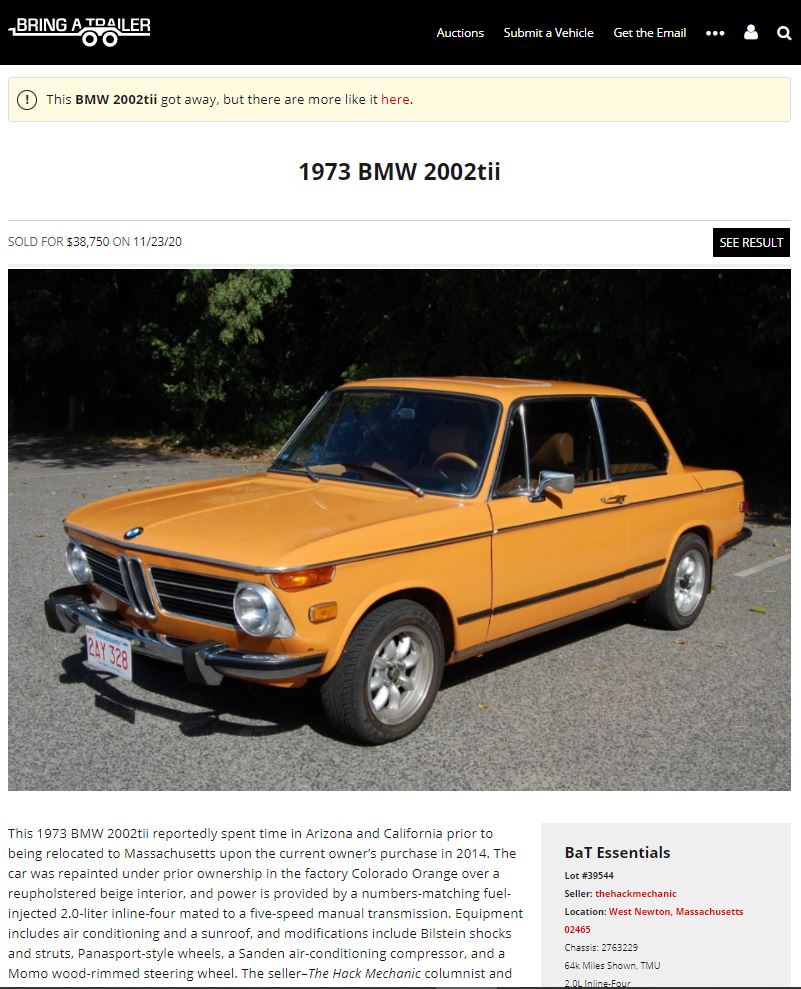
Listing Mike’s ’73 2002tii with BaT was frustrating, but very educational—and highly successful.
My big takeaway from selling Mike’s car was that if you’re thinking of listing a car on BaT, it’s best to think of it as a process involving four separate descriptions:
- The lengthy “warts and all” description you’ll write initially to get everything in one place, and then, once the auction is live, offer to send to interested buyers.
- The BaT description template you’ll fill out during the submittal process.
- The draft description that BaT will send you weeks later, which you’ll work to correct and edit.
- The punchy framing description that you’ll write and submit as the first comment when the auction goes live. This will contain the offer to send the full description to interested buyers.
With all that as context, let’s move on to Hampton.

Lovely Hampton.
Hampton is a 48,567-mile car that I purchased from its original owner. During the nearly eight hours I spent with her, I learned of the car’s history: It was purchased new in New Jersey, stored for a bit in the early 2000s, revived, used as a summer beach car in Southampton, then stored again in about 2010. She told me that the mileage was original, and said that other than a walking-speed front-bumper override that got pushed out, the car had never been hit or repainted.
I believed her, but it wasn’t until I bought the car, got it home, looked through the receipts that she mailed me (she didn’t have all of them in hand when I bought it) and began sorting it that the full flush of the car’s survivor nature washed over me. I’ve described much of that here—how the car’s interior is so original that it makes me want to cry, how the black undercoating in the engine compartment I thought might be hiding accident damage turned out to be Ziebart-like rustproofing that was removable two inches at a time with solvent, how the engine is still wearing the original EGR plumbing and the headlight spacers were still at the tops of the struts, how the door and ignition buzzers still work, on and on.
But when I sorted through the folder of receipts, I found that hard documentation for the car’s sub-49,000 odometer reading was thinner than I would like. What you—and BaT—want to see is an absolutely incontrovertible trail of service records, from new to now, that is dense and roughly equally spaced in time and mileage. If the car is new enough to have a standard seventeen-digit VIN, a Carfax should show the mileage at service visits, state inspections, and purchases and sales. For older cars with non-standard short VINs, service records are expected, but copies of old titles and state inspections can bolster the story.
Although there was zero doubt that the woman I bought Hampton from was the original and sole owner, there were big gaps in the service records. She’d sent me the original BMW service booklet listing a 23,700 mile service in 1980, and a repair receipt from the car’s refreshing in 2004 that listed the mileage at 46,397—but there was nothing between them or after.

This was great to have, but it stopped in 1980.
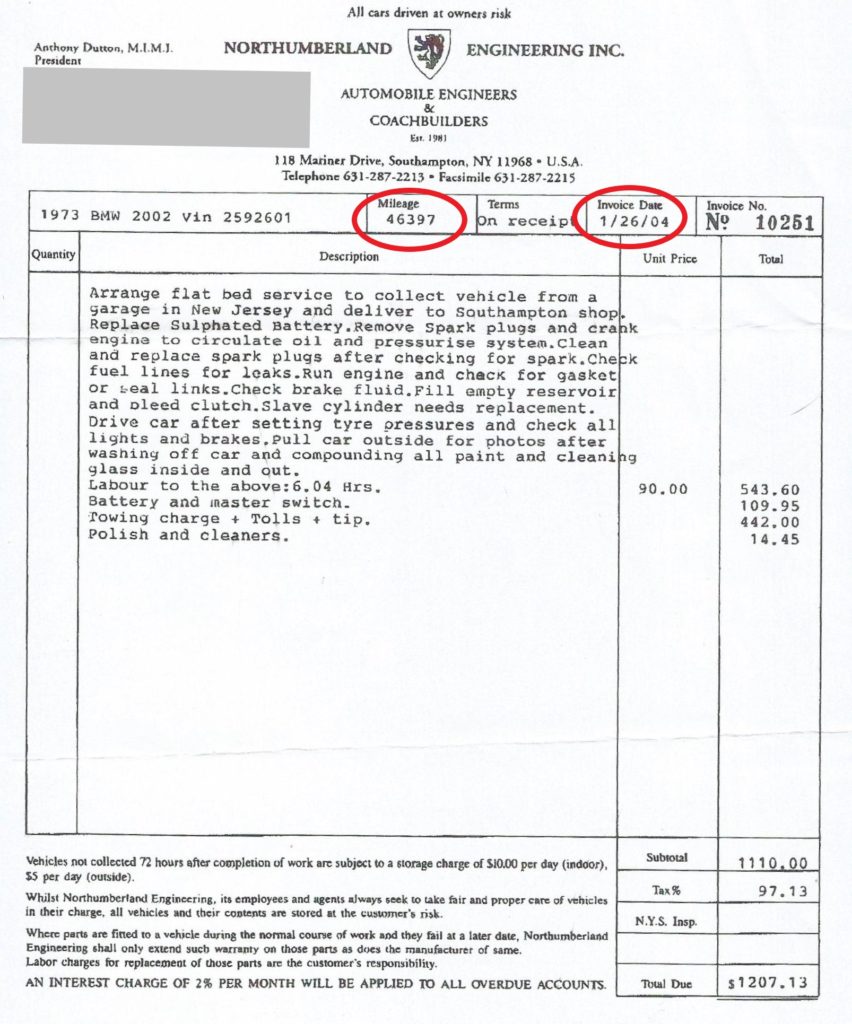
There were other receipts, but this was the only one listing the mileage. And it was 24 years after the last entry in the service booklet. Was it more likely that 22,697 miles or 122,697 miles had elapsed? You need to look at the overall condition of the car to make a judgment.
The cars that do best on BaT tend to be those that present themselves as a unified whole, whether than be bone-stock fresh-from-the-barn original, fully restored, or modified following someone’s well-executed vision. Sellers get in trouble when it’s easy to poke a hole in their unified whole; the classic example is seeing blatant overspray on something spun as an “open-checkbook restoration.” My goal with Hampton was to prepare and present it as the best version of the 48,567-mile, remarkably original, intact survivor that it actually was—one that I’d lightly sorted out without dragging it off its survivor path, hence my obsession with hose clamps and my last-minute decision a few weeks back to replace new rubber fuel hose with new cloth-braided rubber fuel hose.
In writing up my full-on highly-detailed description, I put together a full page detailing my view of how those date and mileage facts, together with the car’s overall condition, the intact EGR plumbing, the utter lack of electrical modifications, the presence of many fragile original parts (including the little plastic covers on the rear-window hinges, the Southampton parking permits and beach stickers on the car from 1989 to 2008, a faded decal on the rear clip from the dealership listed on the service booklet), and other things all synergistically supported the claim of Hampton being an original 48,000-mile survivor car wearing its original paint.
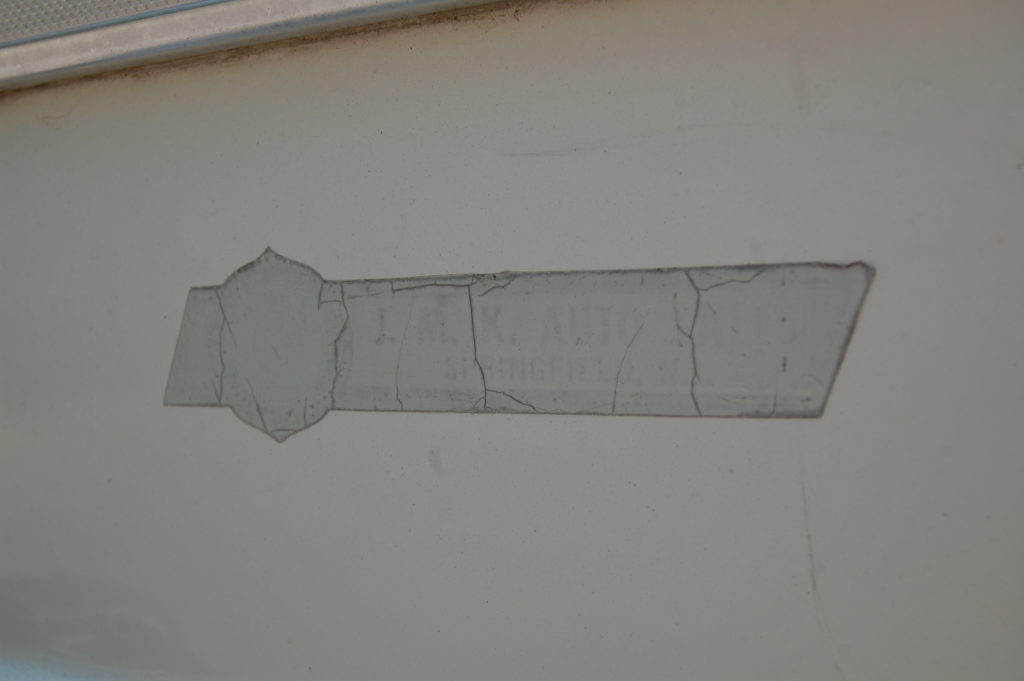
Things like a faded sticker with the original dealer’s name on it don’t prove that the paint is original, but they certainly add to the evidence.
I photographed Hampton, shot highly-detailed walk-around, undercarriage, and driving videos, stepped through the description template, and submitted it all to BaT. I’ll admit that after the critical Hagerty piece I wrote about selling Mike’s tii, I wondered if BaT would blackball me, but Hampton’s acceptance came quickly.
However, a day later, I received this email from BaT: “Regarding the mileage, from the records you sent over, I see we have records confirming the mileage through 1980, and then again in 2004. Is there any documentation from the ’80s and ’90s, or from 2004 and on?” I thought, Oh, crap. This is where it all falls apart. This is where they’ll say, “This 1973 BMW 2002’s odometer reads 48,587” but won’t actually list it in the auction’s title as a 48,000-mile car.
I cut and pasted my page-long explanation of how the mileage, records, and the car’s condition all hang together as a coherent plausible story, emailed the whole thing to BaT, and held my breath. Two days later, I received this response from BaT: “Fair enough! Let’s give this a shot.”
Whew!
The listing process was much easier this time around. Time-frame-wise, it was quite a bit quicker than with Mike’s car; Hampton was accepted on March 23, and I was sent a draft listing on April 9, so it took only about two weeks instead of five, and the listing itself was much better, requiring fewer changes.
There was, however, one odd hiccup. Although BaT bought off on the car’s original mileage in the description, they didn’t include it directly in the title, the way that they do with other low-mileage cars. I still don’t quite understand the reasons the auction specialist gave, but I gently pressed the point, and he acquiesced, for which I am genuinely grateful.
As was the case with Mike’s car, I was prepared to pounce and paste in my own description as the first comment as soon as the auction went live. However, instead of posting a nutshell summary with an offer to send a full description to anyone who asked, I thought I’d try simply posting my entire 3,000-word detailed description for all to see. I wondered, though, if there was a comment length limit. I scoured over BaT’s documentation, but couldn’t find anything.
The listing was scheduled for 9:00 a.m. Monday morning. I waited at my laptop. Up went the auction, with the car listed as “49k-mile 1973 BMW 2002 4-speed” (they rounded the mileage up). I copied and pasted my full-length detailed description as the first comment.
Rejected: too long! Gak!
I hurriedly cut it in half and pasted the first part. Rejected again! Thirds? Nope—but, as per Monty Python and the Holy Grail, the fourth time, it stayed up. BaT’s comment length limit must be somewhere in the 750-to-1,000-word range.
Bids came in almost immediately. Within half an hour, bidding was up to $20,000.

The auction is certainly off to a great start.
Shortly after launch, two remarkable comments were posted. Here was the first: “This was my sister’s car. I put Rob and her together to see if there was interest on his part to purchase it. I can vouch for the fact that this is the original mileage on the car. I would exercise the car while my sister was living elsewhere or traveling, so I know the car well. The car at one point was shipped to California and if I recall correctly it may have spent a year or so in Colorado before being shipped back to NJ. It then sat in a heated, dry garage at my office for years before she moved it out to Southampton, NY. I know she had such a hard time parting with this as it was a graduation present from our father to her. Just know that this car was loved by the whole family since new. Good luck to buyer and seller.”
Wow!
And then this one, from our own eagle-eyed 2002 specialist Delia Wolfe. I’ve never met Delia in person; clearly we’re very different—I the hack, she the professional who prepares concour-winning cars—but I think that we share the quality that we’d convict our own mother if there was the evidence to do so. This was her comment: “I see nothing here to doubt the originality claims by the Hack Mechanic. It’s so rare for an unmolested, one-owner example to show up here of BaT (or anywhere else, for that matter). It’s hard to parse what nearly fifty years of ownership, maintenance, and obvious care looks like. (And when the original owner’s brother chimes in, that pretty much eliminates any speculation to the contrary.) After poring over the gallery of images, this auction car is a wonder to behold. The seat vinyl appears to remain supple and the subtle variations in color/tone/texture of the original carpet kit is something that cannot be replicated by modern methods. And while the tar-like rustproofing may be a turn-off to some, it has does its job remarkably well–preserving the factory applied finishes in a manner that rivals La Brea. Pretty sure Rob has taken the time to address whatever immediate needs that have presented themselves in his relatively short tenure as owner. Bid with confidence. I’m just gonna sit back and watch this one from the sidelines.”
Wow a second time.
(And yes, I took a good-natured ribbing in the comments from BimmerLife readers about hose clamps!)
So, while there are still things about BaT that drive me nuts, I must admit that without the enlightened flexibility on their part about Hampton’s service records and mileage, the listing wouldn’t be generating the kind of heat and light that it is. And without the social-media-based sure-let’s-accept-comments-from-anyone design of their platform, I never would’ve gotten these two comments that are absolutely central to validating the car’s provenance and condition. It’s difficult to imagine another sales context—word of mouth, face to face, eBay, Facebook, Craigslist, BMW CCA Classifieds—where the presence of these comments would be so directly beneficial to me.
So thanks, BaT. Seriously. I don’t think that you were giving me special treatment to get me to tone it down, but, yeah, I’ll tone it down. But do you have to keep writing “Power is routed to the rear wheels via a four-speed manual transmission”? Really, it’s just embarrassing.—Rob Siegel
Rob’s upcoming book, The Best Of The Hack Mechanic: 35 years of hacks, kluges, and assorted automotive mayhem from Roundel magazine, will be out in the spring. His seven other books are all available on Amazon, and signed copies can be ordered directly from Rob here.


